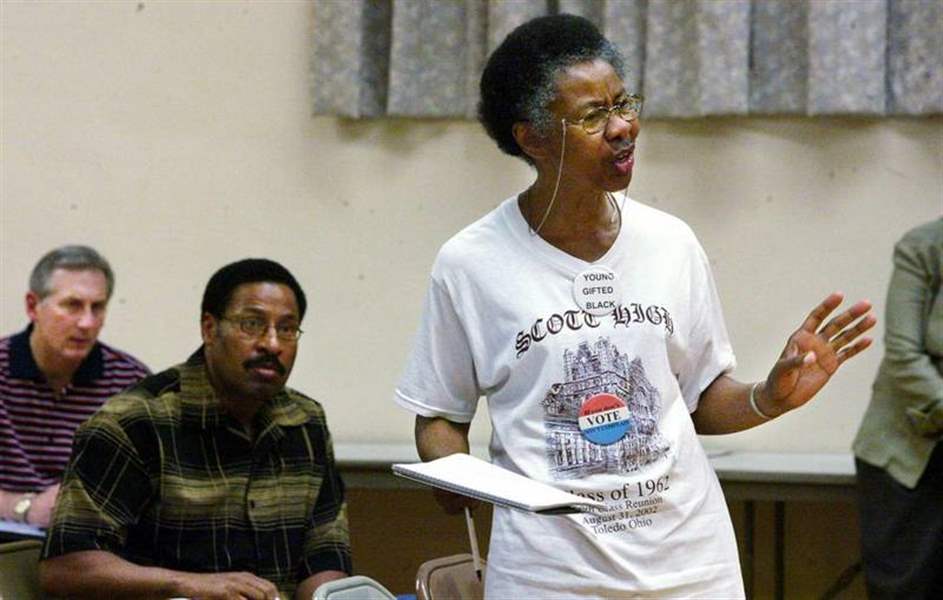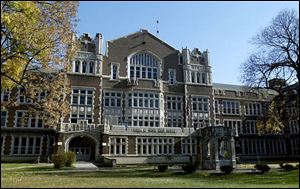
Battle continues to save Toledo's Scott High
7/7/2008
Shirley Smith, Class of 1962, addresses the Ohio School Facilities Commission at a meeting about the future of Scott High School attended by Lawrence Wood, Class of 1973, center, and Dan Romano, left, Toledo schools district treasurer.
Scott High School alumni and neighbors are passionate about its renovation.
To them, it's about more than saving the four-story brick structure that has stood along Collingwood Boulevard for nearly a century.
It's about retaining an anchor of the Old West End community. It's about keeping a symbol of inspiration for current and future Bulldogs to follow in the footsteps of successful alumni who have walked the same halls.
"It's a landmark, and if you eliminate that landmark, you compromise the makeup of the neighborhood," said Robert Davis, president of the school's alumni association. "When do we stop destroying our history and our landmarks for future generations to enjoy?"

Scott is Toledo s oldest public high school, opening to students in 1913. The structure cost nearly $750,000 to build.
Toledo Public Schools maintains there are no plans to tear down Scott and that was never the intent. But the money is not there for a full-scale renovation that would be required in the district's $620 million Building for Success program that is mostly funded with Ohio School Facilities Commission dollars.
"They want the best for Scott and so do we," Superintendent John Foley said.
When Scott was built in the early 20th century, schools were reacting to law changes that required more students to attend high school, explained Barbara Powers, head of the inventory and registration department of the Ohio Historical Society's preservation office.
"As a result, in part, these buildings are really being seen as symbols of education and the importance of education in a community and for its citizens," she said.

Shirley Smith, Class of 1962, addresses the Ohio School Facilities Commission at a meeting about the future of Scott High School attended by Lawrence Wood, Class of 1973, center, and Dan Romano, left, Toledo schools district treasurer.
Scott's construction began in 1910 and it welcomed its first students in September, 1913. The oldest public high school in Toledo, the 260,000-square-foot building cost nearly $750,000 to build.
An English Gothic-style building with terra cotta trimmings and a green tile roof, it was built with 23 classrooms and laboratories, a gymnasium,an auditorium, a library, and a cafeteria.
At its 1931 peak, Scott had 2,370 students. About 925 students are enrolled now.
Buildings of the time were made with high-quality materials including brick, stone, and marble. Their design borrowed greatly from the college style and are commonly referred to as Collegiate Gothic, Ms. Powers said.
"They were trying to build these very magnificent buildings that have this sense of tradition and importance of education in the community," she said.
Scott and the nearly identical Waite High School were designed by David Stine, the same architect who designed the Lucas County Courthouse. The construction of Waite also began in 1910, but it did not open for classes until 1914.
Royce Yeater, director of the National Trust for Historic Preservation's Midwest office in Chicago, visited Toledo when the district was getting started on its building project and said he was impressed by the large, beautiful high schools in an urban city.
He advocated for preservation then and continues today, citing three arguments to renovate existing schools - the cultural significance as points of community pride, many can be rehabilitated with good planning for the same costs as building new, and it's a "green" practice keeping existing materials in use.
While not officially recognized as a historic building, Scott lies within the Old West End district that is listed on the National Register of Historic Places.
Supporters of the school list its importance in that community right up there with the Toledo Museum of Art and Rosary Cathedral.
Judy Winder, head of the Old West End Association's preservation committee, said Scott was built to last but needs renovation to make it a more desirable education setting.
"We would love to have a school where everybody down here would be more than willing to send their kids," she said. "People just aren't comfortable with the school system and they would so much like to be."
The Old West End Association has started working with the Scott alumni group to coordinate efforts to "Save Our Scott," the name of the umbrella group that is trying to find ways to help. That could include hiring a professional fund-raiser and turning to successful alumni.
Scott has graduated the likes of Olympic champion boxer Wilbert "Skeeter" McClure, former San Francisco 49er Willie Harper, and Foy Kohler, who served as a U.S. ambassador to the Soviet Union in the early 1960s.
It's important to note that no schools are included for renovation in the district's building plan.
If Scott were taken out of the plan, it would join Waite and the old DeVilbiss High School, which now houses Toledo Technology Academy, and Crossgates, Glendale-Feilbach, and Harvard elementary as the schools left to be renovated with local dollars.
Waite on Toledo's east side is as old as and almost identical to Scott, but the fact that it's out of the plan hasn't gotten as much attention.
Waite Principal David Yenrick, who also is a 1974 graduate of the school, said strong alumni support has helped while they wait on the district's plan.
"We've been sitting very quietly, staying under the radar," he said.
Waite's alumni have spent close to a half a million dollars over the last 10 years to help renovate the school.
Mr. Yenrick said it's a tough situation because the OSFC, which provides 77 percent of the money for the district's building project, favors new construction.
"There should be some kind of formula for historic buildings," he said. "People in all of Toledo would be very disturbed if they tear down Waite or Scott."
Superintendent Foley said when the building program started, the $800 million project included nearly all of the district's buildings. As it was cut to $620 million, buildings were taken out - including plans for six middle schools, without which overcrowding has become a problem.
The school board is in the process of asking the facilities commission for a waiver that would give it more time and flexibility in the building plan's final phase, which includes Scott and 10 other schools.
With more time, perhaps local funds or grant money could be raised for building renovations, or other creative options can be considered. "It's a challenge," Mr. Foley said. "There are politics, community interests, and all our constituents' special interests, and we have to do what's best for the district and what's best for kids."
Contact Meghan Gilbert at:
mgilbert@theblade.com
or 419-724-6134.